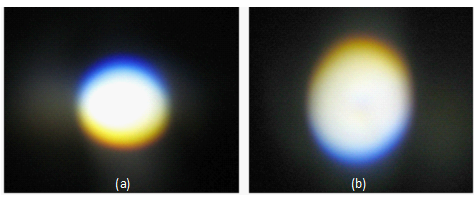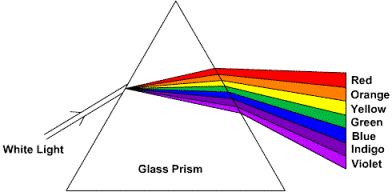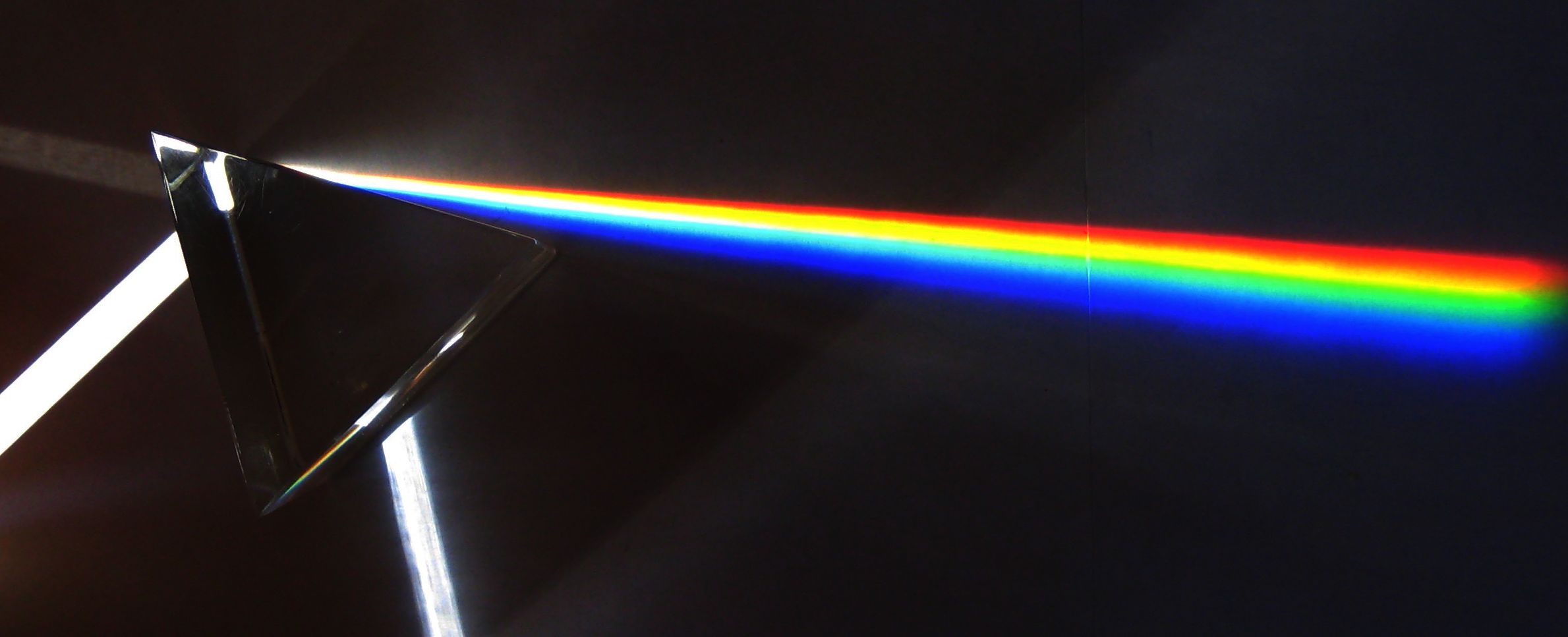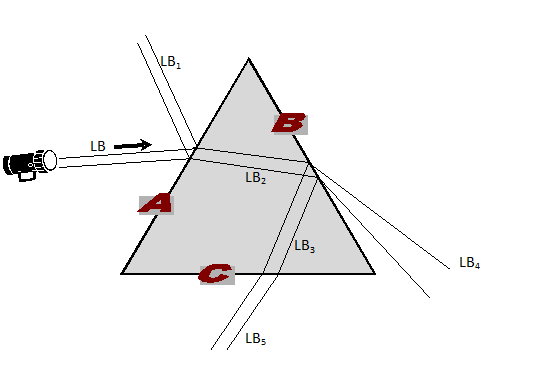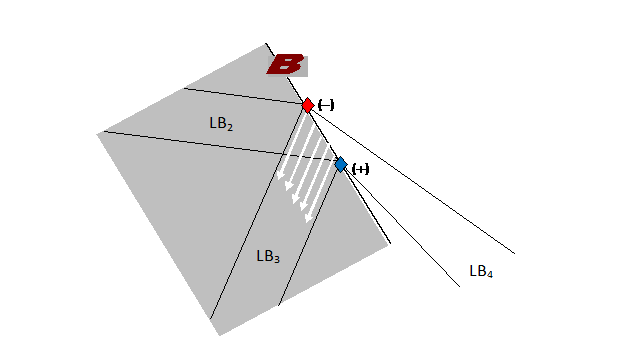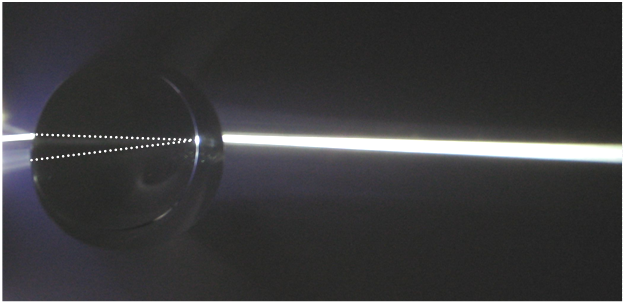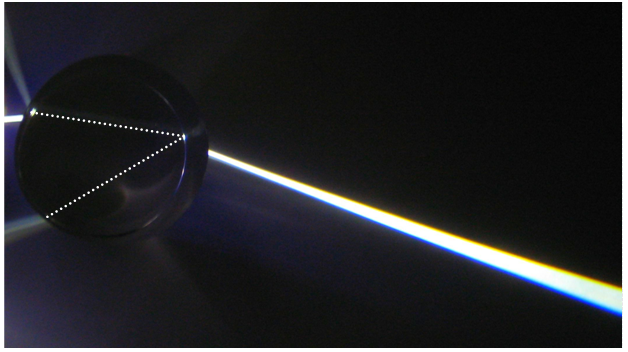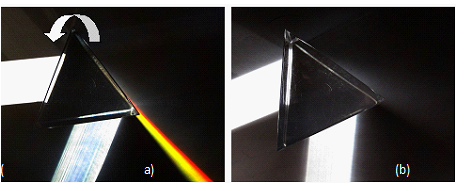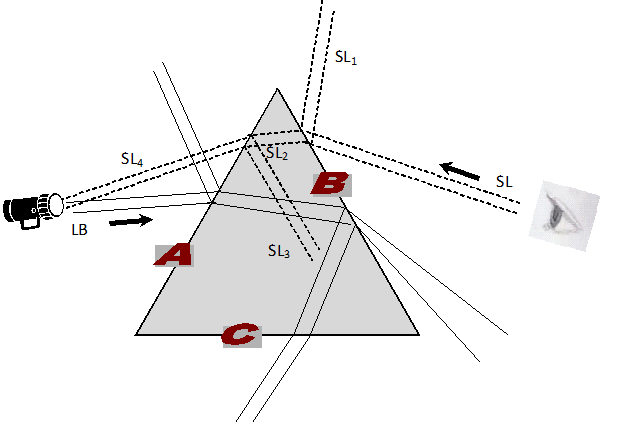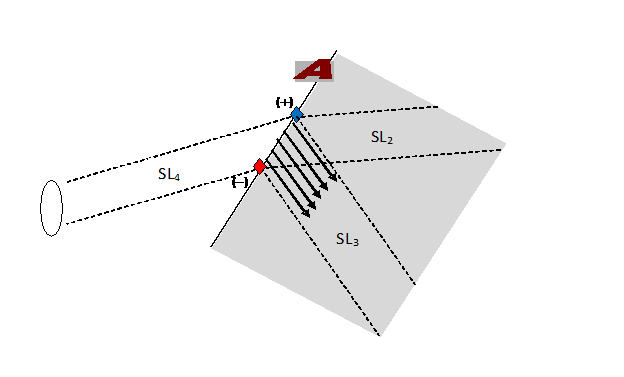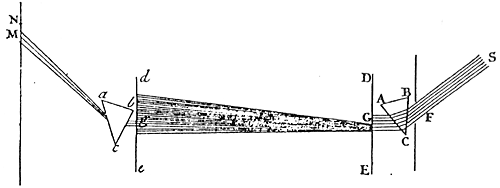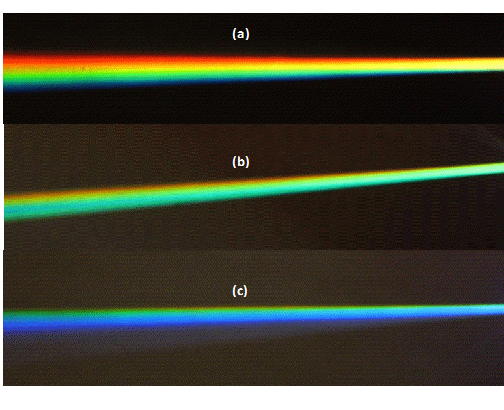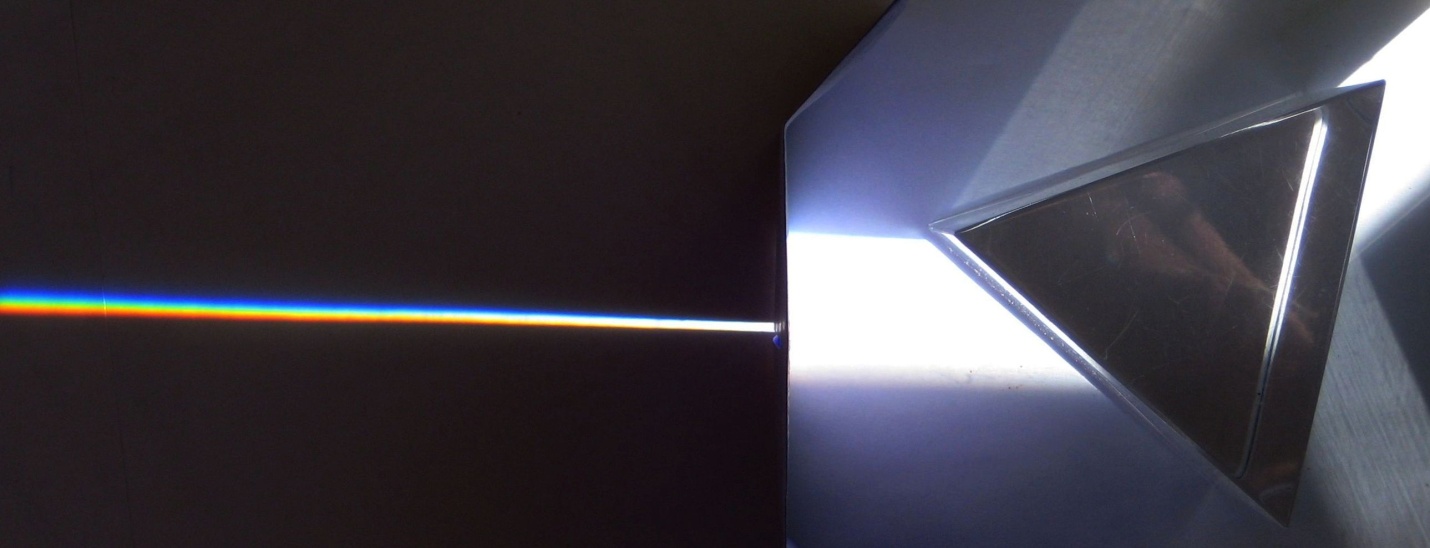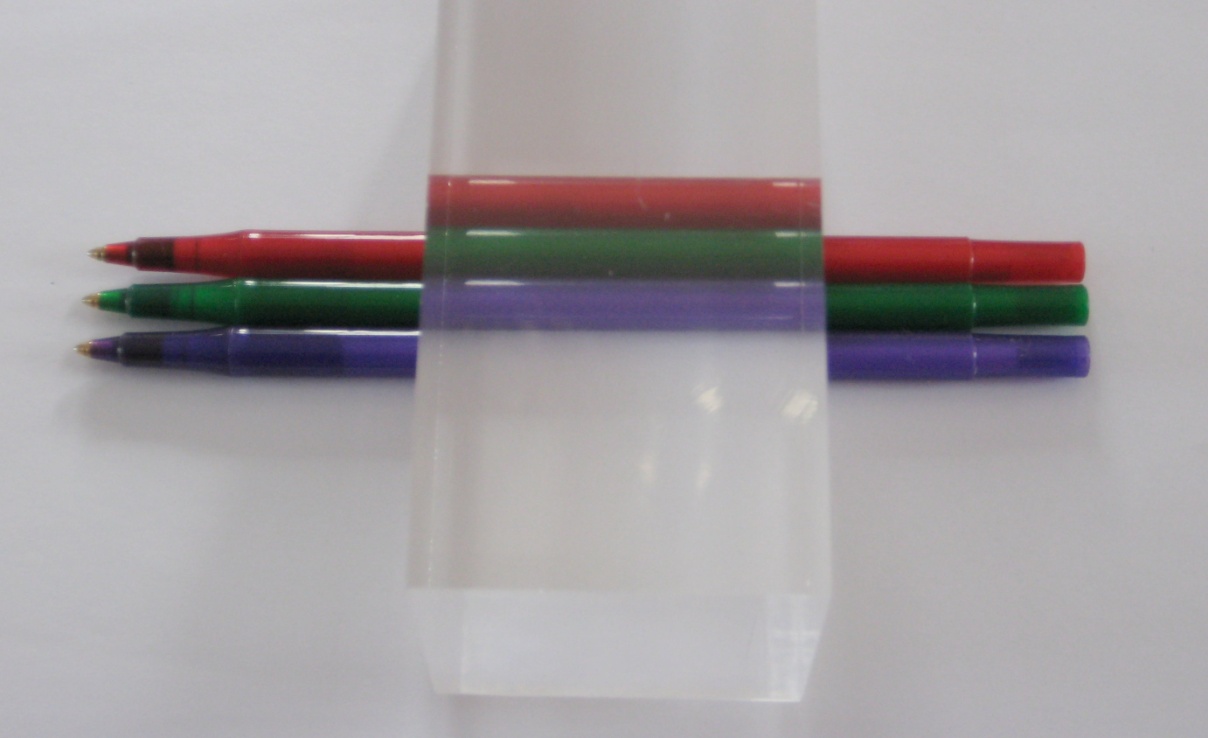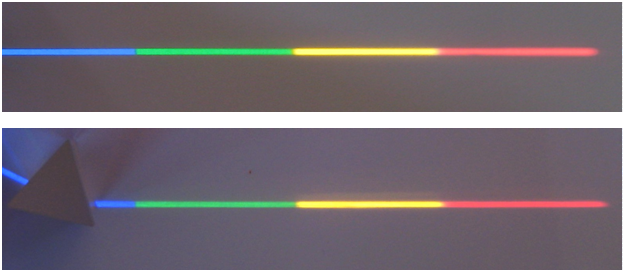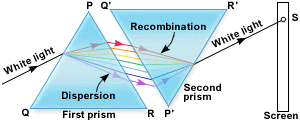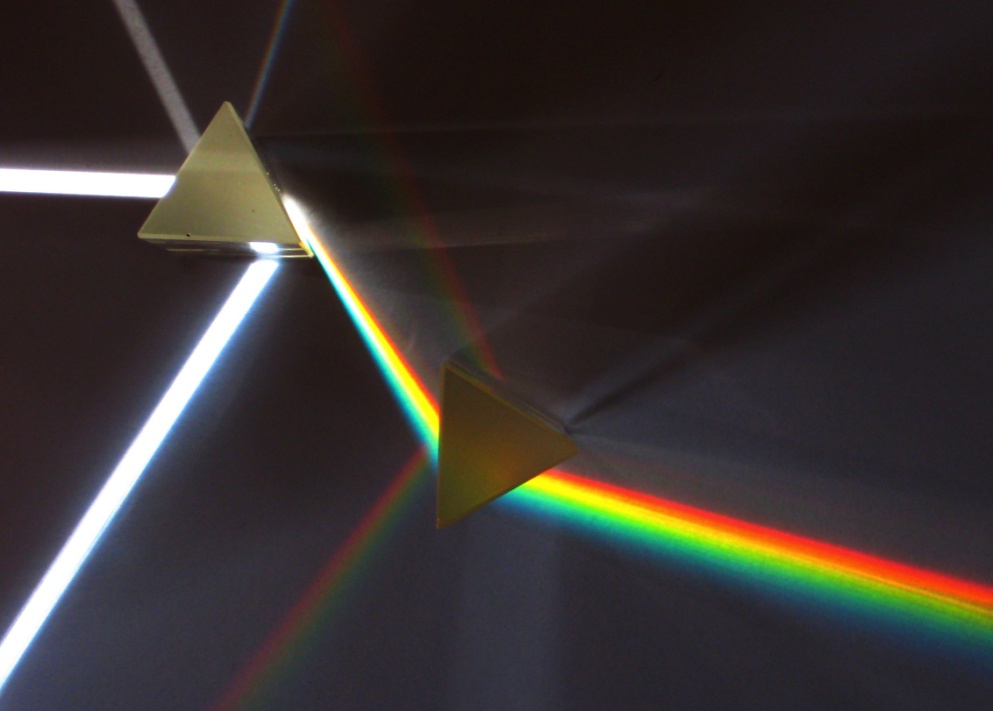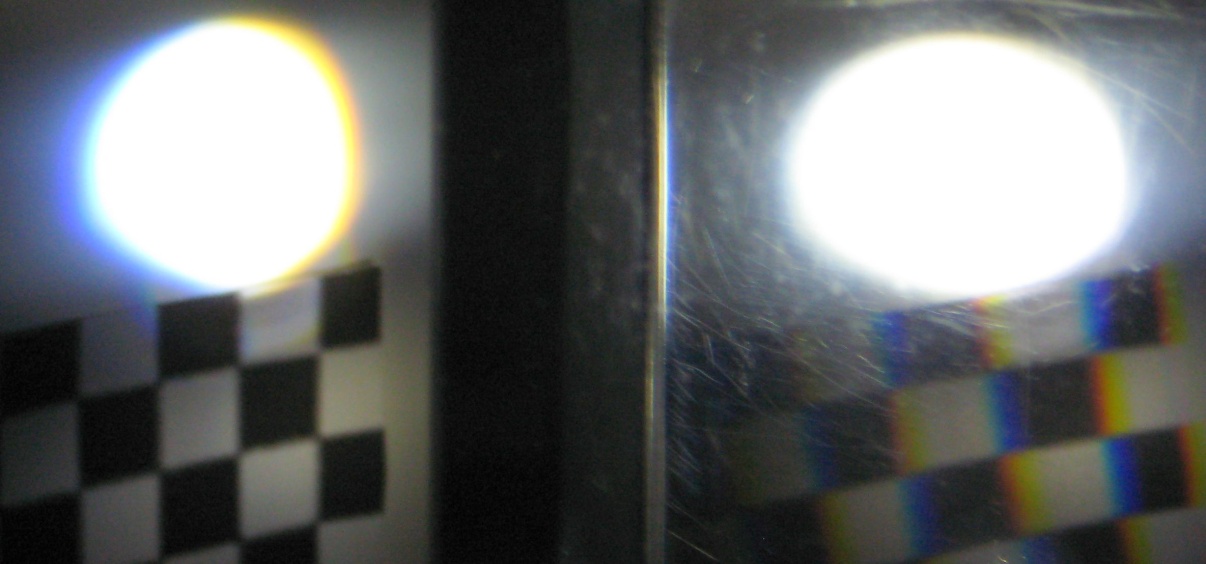Part 1, The Dynamic Interplay of Light and Darkness, introduced the holistic colour science of Johann Wolfgang von Goethe in relation to the ancient Chinese concept of Tao. Goethe’s participatory study of colour phenomena beautifully meshes with Taoist principles; the polar opposite forces of light and darkness interact in a lively and harmonious exchange of colours that awaken our senses and emotions. Part Two delves more specifically into the interplay of light and darkness through a prism and offers additional thoughts on colour manifestation from the qualitative, Goethean perspective.
Reflecting on the Matter
Through his intensive study of colours, continually seeking unified relationships among the manifold cases, Goethe was able to identify the core situations where nature created polar ranges of colours. These primal phenomena are repeated from the previous article:
Light emitted through a colourless, transparent medium first manifests as white. As the medium becomes denser and the transparency decreases, the light darkens to hues of yellow, orange, and red. The sun takes on these hues depending on whether it’s overhead or near the horizon where the atmosphere is thicker. At the extreme end of densification and opacity, light is shut out to black.
Darkness illuminated through a colourless, transparent medium first manifests as black. As the medium becomes denser and the transparency decreases, the darkness lightens to hues of violet, indigo, and blue. The black night sky becomes modified by the sun’s daytime illumination and displays a range of these hues, from dark blue overhead to light blue near the horizon. At the extreme end of densification and opacity, darkness is diminished to whiteness.
What continued to perplex Goethe for many years after publishing his colour studies was why a prism was able to create these primal opposite bands. He initially offered an analogy to help explain the dynamic interplay of light and darkness, comparing the situation to a mirror with thick glass that gives a double image. A “main image” vividly reflects from the back metal coating, while an offset “accessory image” more weakly reflects from the front surface of the glass. He suggested that light refracted by a prism somehow creates an accessory image that lengthens the original main image, spreading light into darkness and darkness into light at the edges. As a result, the red-yellow band would appear at one edge and the blue-violet band at the other edge.
Mainstream science has soundly rejected and ridiculed such a notion. Even those on the pro-Goethean side of the debate, such as Proskauer, Lehrs and Sepper, conceded that Goethe’s attempt at such an analogous explanation was weak, leaving the process an enigma for Goethean science to this day.
But have friends and foes alike been too hasty in their judgment? By “reflecting on the matter,” perhaps the role of reflection in the prism has been completely overlooked while refraction has taken centre stage. Maybe Goethe was much closer to solving the riddle than he realized. With this in mind, we’ll consider two anomalies which perplex the Newtonian colour theory, but can be plausibly explained in terms of Goethe’s primal phenomena.
Anomaly 1 – Different Colour Orientation Between Objective and Subjective Spectrums
When looking through a prism towards a light object surrounded by a dark background, a subjective spectrum is said to be produced. When a light beam shines through a prism and is projected on a screen, an objective spectrum is said to result. As it turns out, the subjective spectrum is the inverse of the objective spectrum (Figure 1) with respect to colours, and such a difference contradicts the accepted Newtonian explanation. Figure 2 shows an erroneous educational depiction of a prism supposedly separating colours contained in the original light. If this depiction were correct, the orientation of coloured fringes should be consistent on both images in Figure 1 – reddish above, bluish below.
This observation of inversely coloured images was published in the “Philosophical Transactions of the Royal Society” in 1676 as part of a critical review of Newton’s theory of colours. Anthony Lucas, a Jesuit professor, identified several conditions where colour phenomena clearly conflicted with the theory, and this particular observation was one of them. If blue coloured rays refract more than red, then how could these images be reversed? In correspondence with Lucas, Newton’s rebuttal was evasive rather than revelatory, as it didn’t adequately address the issue in relation to the new theory. Given Newton’s stature at the time, the objection quickly faded into obscurity where it has essentially remained unanswered ever since.
Goethean science, on the other hand, offers a plausible explanation for the inversely coloured images. The following tentative interpretations are suggested:
Objective Spectrum
Figure 3 is a photo of a light beam interacting with a prism. In addition to the beam emerging with the coloured fringes from the right face, other non-coloured beams emerge from the left face and bottom face. The various paths of light are due to a combination of reflection and refraction, both internally and externally; the prism faces act simultaneously as both mirrors and windows.
Figure 4 is a pictorial representation of this dual mirror-window process. The original light beam (LB) is first split at face ‘A,’ reflecting (LB1) in the air and refracting (LB2) inside the prism. The beam LB2 then reflects internally (LB3) at face ‘B’ and refracts (LB4) out of face ‘B’ where the coloured fringes develop. From the lower face ‘C’ emerges a refracted beam (LB5). The internally reflected light at face ‘C’ is not shown, as it is very weak in intensity.
To interpret the orientation of the coloured fringes of the objective spectrum, Figure 5 isolates a portion of face ‘B’ at the junction of light beams LB2, LB3, and LB4. The white arrows inside the prism represent the direction of lightening as internally reflected beam LB3 laterally shifts light from beam LB2. This shift through the dense medium causes darkening at the upper light edge of LB2 (designated as negative) and lightening at the lower dark edge of LB2 (designated as positive). The result is a reddish upper fringe where the light edge is darkened and a bluish lower fringe where the dark edge is lightened. Beam LB4 shines through face ‘B’ to spread out these edge colours in full splendour.
An equilateral prism isn’t the only shape where this phenomenon occurs. The same coloured fringes can be seen emerging from a cylindrical transparent medium. If the angle between the beams inside the medium is small, the coloured fringes don’t appear. Once the angle opens to a much greater degree between the beams, the coloured fringes then become apparent. Refer to Figures 6 and 7.
Figure 8 depicts what happens to an objective spectrum when a prism is rotated to the verge of internal reflection. The violet-indigo-blue portion of the spectrum begins to disappear from the externally refracted beam, bleeding the bluish colour back inside and tinting the lower beam. Once the prism is rotated further, the spectrum disappears with total internal reflection.
Subjective Spectrum
The interpretation of the subjective spectrum requires us to consider sight lines as opposed to light beams. First of all, if you look directly into emerging light beam LB4 (as depicted in Figure 4), you do not see the inverted image of colours. Because of the sensitivity of your central vision1, you actually see a bright coloured beam, not an entire image of coloured fringes. The colour of the beam coming towards you varies with subtle head movement. It may be yellow at one instant, white the next, or perhaps blue the next. The orientation of the colours with your head movement matches the orientation of the coloured beams emerging from face ‘B’ in the objective spectrum.
To see the inverted image of the subjective spectrum, your line of sight actually has to be above the light beam as shown in Figure 9. The dual mirror-window process of the prism works with sight lines as well, causing reflection and refraction as depicted by the dashed lines. Figure 10 isolates a portion of face ‘A’ at the junction of sight lines SL2, SL3 and SL4. Sight line SL4 is looking towards the round light source at an oblique angle to the light beam itself. The black arrows inside the prism represent the direction of darkening as internally reflected sight line SL3 laterally shifts darkness from the image projected back along sight line SL2.This shift through the dense medium causes the sensation of lightening at the upper dark edge of the image (designated as positive) and darkening at the lower light edge of the image (designated as negative). The result is the appearance of a bluish upper fringe where the dark edge is lightened and a reddish lower fringe where the light edge is darkened.
Anomaly 2 – “Homogenous” Spectrum Colours Tinted by Coloured Fringes
The prevailing scientific colour theory is based on Newton’s experimentum crucis, the crucial experiment, as illustrated in his Opticks (see Figure 11). By setting up his experiment in this fashion, he was supposedly able to isolate single, homogeneous colours of the spectrum for analysis through a second prism. The discrete entities are said to refract at different angles – “diverse refrangibilty.”
Isolating individual spectral colours is easier said than done. Figure 12 shows the results of three attempts to isolate different colours that emerged from a prism. When a narrow slit was placed in front of each colour, the beams that continued past the slit didn’t maintain their colours, but spread out and developed multi-coloured fringes. An attempt to isolate a white beam met with no better success. A wide white beam that emerged from the prism was narrowed through the slit and, instead of a thin white beam shining through, a narrow spectrum with green in the middle developed as the beam spread out. Refer to Figure 13.
In the seventeenth century, Edmé Mariotte, a highly credentialed French natural philosopher, tried to verify Newton’s crucial experiment. Yet he encountered the problem with coloured fringes when attempting to isolate individual colours. The pesky anomaly to the theory persisted for many years, until Newton requested an improved version of the crucial experiment through the Royal Society. The experimenter, Jean Théophile Desaguliers, a close personal friend of Newton, was hardly an unbiased observer. The only way he could uphold Newton’s conclusion was by substantially altering the experimental setup (the “refinements” required three apertures, two prisms, a plane mirror and a collimating lens). It begs the question: Was this really the same crucial experiment, or was it a case of manufacturing the desired outcome by introducing more complicating media that modified the light with additional reflections and refractions, ultimately cancelling the coloured fringes?
In any event, over a century later, the theory again hit a snag when an eminent physicist came to a contrary conclusion. Sir David Brewster, famous for inventing the kaleidoscope, encountered coloured fringes in his experiments with light absorption and prisms. Using light filtered through a blue coloured glass, he transmitted it into a prism to study the result. The unique band of colours which developed from the original blue beam took him by surprise. He concluded that green wasn’t a homogenous colour after all, but could be decomposed into yellow and blue. It led him to state: “Difference of colour is therefore not a test of difference of refrangibility [his emphasis], and the conclusion deduced by Newton is no longer admissible as a general truth.”
This was quite a startling statement from a classical physicist, one who would have undoubtedly scoffed at Goethe for coming to the same conclusion a few years earlier. Goethe and other Newtonian dissenters before him clearly demonstrated by several means that different colours have the same angle of refraction. Figures 14 and 15 are two simple demonstrations showing how different colours refract equally.
Returning to the tentative interpretation offered for Anomaly 1 in this article, such a Goethean explanation is suggested for the coloured fringes; in fact, it applies in general for the action of the prism. Whether one considers light beams (the objective spectrum, Figure 5 sketch) or sight lines (the subjective spectrum, Figure 10 sketch), the dual mirror-window interface within the dense, transparent medium develops the propensity for primal colour manifestation. Perhaps internal reflection transversely passing through the original light path or sight path generates a lateral force – a cross current, so to speak, within the axial current. Like the warp and woof of a fabric, the spectral colours develop as the cross current dynamically weaves light over darkness and darkness over light at the edges, regardless of whether the initial projected colour is white, yellow, blue, or whatever hue.
Multiple Effects
The governing colour theory is reinforced through a common depiction (Figure 16) that supposedly proves how two prisms can decompose and recompose pure “white light.” Through formal schooling and popular science, this concept has grown to the point of iconic status. Accepted on faith, it all seems quite factual and logical. However, if you try the demonstration for yourself, it’s certainly not as portrayed. Figure 17 is an actual set-up with two prisms, and the results are dramatically different from an artist’s rendition. The complex mingling of refracted and reflected light beams through the second prism develops coloured fringes exiting two faces. In fact, when considering the second prism alone, one could argue that red light refracts more than violet light! Demonstrations are posted on university websites that claim “success” with this experiment. Using more sophisticated equipment, they display a narrow white portion projected through the second prism, bordered by wide coloured spectrum bands, bluish on one side, reddish on the other. No mention is made of these coloured bands.
Figure 18 provides another demonstration of multiple effects at play. The photo was taken from the vantage point of a light source situated at the lower right corner directed towards the prism on the right (standing vertically on edge). On the left was a white card that had a checkerboard pattern below, and the beam that emerged from the prism was projected onto the upper white portion. The right portion of the photo is the image that appeared to the eye when looking inside the prism. The left image has coloured fringes around the lighted circle, whereas the image of the lighted circle inside the prism has no coloured fringes, yet coloured fringes appear at black and white edges of the checkerboard pattern. Note that the orientation of the reddish and bluish colours are the inverse of those around the lighted circle to the left.
With the prism standing vertically on edge, the coloured fringes appear along the horizontal axis, orientated left and right. Goethean interpretations of these various effects are as follows:
Refer again to Figure 5 (the orientation is different, but the principle is the same). The coloured fringes which appear on the lighted circle at the left side of photo are due to the lateral shifting of the internally reflected light beam toward the left from the back face of the prism. The shift through the dense medium causes darkening at the right edge of the beam and lightening at the left edge. The portion of the beam that emerges from the prism shines through the back face to illuminate these colours on the card – bluish left, reddish right.
Two cancelling effects are at play to cause no coloured fringes to appear on the right side of the photo. Refer again to Figure 10. The line of sight in this case is along the same horizontal axis as the projected light beam. The sight line reflects internally toward the left from the back face of the prism, laterally shifting darkness through the dense medium. The shifting of the darkening effect is in the same direction as the shifting of the lightening effect noted in 1) above. The consequence is that these two lateral effects cancel one another and there is no net change to the edges of the white circle. Thus, the circle appears white.
When looking at the checkered pattern, Figure 10 explains why coloured fringes appear when looking inside the prism. This shift of sight lines through the dense medium causes the sensation of lightening at the right dark edge of the white squares and darkening at the left light edge of the white squares. The result is the appearance of bluish right fringes where the dark edges are lightened and reddish left fringes where the light edges are darkened.
Colourful Dogma
Although Newton had many critics of his then new colour theory, through all the Royal Society correspondences, he defended it tenaciously as a fact, not a theory. Newton continually countered his critics by claiming his conclusion was a self-evident fact based on the experimentum crucis.
Goethe in his day also took strong issue with the supposed factual conclusion. He commented, “This first and greatest mistake must be noted above all. For how can one hope for advances in science if that which is merely concluded, opined, or believed is allowed to be forced upon us as a fact? … Let future revisionists therefore be requested to see to it that no one, whoever he may be, be allowed to pass off an explanation, theory, or hypothesis as a fact.”
Once a scientific theory is permitted to harden to a fact, it is an immense struggle to overcome the bias. Imre Lakatos, a distinguished mathematical and scientific philosopher, spoke of the predictable response to challenges: “Scientists have thick skins. They do not abandon a theory because facts contradict it. They normally either invent some rescue hypothesis to explain what they then call a mere anomaly and if they cannot explain the anomaly, they ignore it, and direct their attention to other problems.” Newton’s colour theory represents a classic case of this very type of response, not only at the onset, but continually bolstered by faithful followers. In Goethe Contra Newton, Dennis Sepper explains how the defensive posturing and politics strike at the very core of science itself, cracking the façade of a virtuous, progressive and objective venture:
Newton took his opponents’ criticism and even their hesitancy as blindness to the truth and regarded all attempts to explain the phenomena by other means as inferior … He treated even his most eminent adversaries with barely concealed condescension and annoyance … and the lesser participants had to endure pedantic lectures on the proper method of arguing and deciding the truth in natural philosophy. … Newton was therefore never compelled to engage the profound issues that he himself had raised … [instead he would] conceal and ossify it [his colour theory] ever more completely with masses of experiments, improperly qualified claims, and a veneer of mathematics. For in Newton’s case we are talking about a scientific success that decisively influenced the natural sciences for generations. Insofar as these shortcomings and this dogmatism went unnoticed and uncriticized, we have to deal with a significant failure of early modern science itself.
The theory has become so ossified that even critics of the dominant scientific consciousness have fully accepted the dogma. Cultural historian Morris Berman, who rallies the call for a more participatory, post-modern science to counter the alienating and nihilistic trend of reductionist thought, objects to Newton’s atomistic approach. Although Berman notes that the theory never really explains why colours should be innate properties of light, he concedes that Newton’s experiment “establishes the thesis beyond doubt.” On the contrary, the doubts and anomalies have been banished from consideration and simply remain in exile.
Conclusion: The Essence of Colours
Newton was clearly a man of immense genius and his stature as a leading figure within modern science is undeniable. Yet there was another side to his work that is largely unknown; he spent many years of his life – perhaps more than he dedicated to his famous scientific treatises – deeply engrossed in the practice of alchemy. Manly Hall, founder of the Philosophical Research Society, refers to alchemy as a “threefold art … the divine, the human, and the elemental” – corresponding to spirit, soul, and body – not the “ridiculed and despised craft“ that’s popularized and distorted as simply a material quest to turn physical lead into gold. The true practitioners’ motto was, “Our gold is not the gold of the vulgar,” for alchemy was the Great Work aspiring to the highest principles. Hall further noted, “it can easily be appreciated why the sages and philosophers created and evolved an intricate allegory to conceal their wisdom.” Thus, Newton’s interest in alchemy and sacred symbolism was a well guarded secret until descendants auctioned his private manuscripts in 1936.
In a sense, Newton appears to have been the epitome of the Cartesian mind-body split. On the one hand, he was a pure materialist, while on the other, a sincere esotericist. Yet, it is his materialist side that has prevailed, fueling the industrial revolution and so dominating the outlook of modern civilization. His goal to reduce colours to fixed geometry and mathematics (not sacred geometry or sacred number), effectively drove the ethereal down to the corporeal level. It represents an exemplary case of the “reign of quantity” that René Guénon, French metaphysician, so lucidly presented – a significant step in the descent from “essence” to “substance.” The impact of the governing theory has solidified the concept of colour manifestation, deadening it in the process.
Within the scientific (or, shall we say, scientistic) establishment, Goethe’s polemical attack on the Newtonian colour doctrine met with scorn and derision. As a man of letters and not numbers, Goethe was considered to be completely out of his element, no match to Newton’s experimental and mathematical acumen. Yet it may come as a surprise that he had something very much in common with Newton; Goethe also had a profound interest in alchemy and it heavily influenced all his work. The difference was that Goethe never parceled off the sacred as a separate domain. For him, the goal of a natural philosopher (what it was called before the term scientist came into being), was a qualitative venture to find correspondences, relationships and unity in nature. The world was whole; art, science, and spirituality were never meant to be cut off from one another.
When Goethe studied the phenomena in the natural philosophic tradition, he strove to elaborate a holistic colour science with the spirit in the forefront. He bristled that science was sinking deeply into a mechanistic and quantitative abyss; to him, secular mathematics was a “scientific coffin.” He knew he faced an uphill battle against the dogma, for he stated, “I shall do my best all the same, so that even if I too am damned as a heretic, at least a more fortunate successor may find a usable preliminary work.” Let’s hope that more centuries don’t pass before a successor is able to restore the spirit of colour inquiry and set the record straight on the essence of colour phenomena.
Figure 1
Inverted colour orientation from the same light source. At left, looking through a prism towards a light as it enters the prism, the subjective spectrum (a). At right, looking away from the prism at the image externally projected onto a card, the objective spectrum (b).
Figure 2
Erroneous educational depiction of how a prism is supposed to “disperse” light into component “parts” in geometric precision, both within the prism and outside the prism.
Figure 3
A prism reflecting and refracting light at all three faces.
Figure 4
The dual mirror-window process of the prism causing light beam (LB) to reflect and refract (deflect) both internally and externally.
Figure 5
Isolated view of a portion of prism face ‘B’ from Figure 4 where coloured fringes disperse from light beam LB4. The white arrows signify the direction of lightening across beam LB2.
Figure 6
Light entering a cylinder from the left. The exiting beam on the right has no coloured fringes when the angle (designated by the dotted white lines) between the internally refracted and reflected beams is small.
Figure 7
Light entering a cylinder from the left. The exiting beam on the right has coloured fringes (red-yellow on the top edge and blue-indigo on the bottom edge) when the angle between the internally refracted and reflected beams is greater.
Figure 8
The arrow indicates the direction in which the prism was rotated (a) to obtain total internal reflection as seen in (b) where the colours disappear.
Figure 9
Sight line (SL) looking back through the prism gets reflected and refracted.
Figure 10
Isolated view of a portion of prism face ‘A’ from Figure 9 where coloured fringes appear along sight line SL4.The dark arrows signify the direction of darkening across sight line SL2.
Figure 11
Illustration from Newton’s Opticks showing the setup for his experimentum crucis, or crucial experiment. A single colour emerging from prism ‘ABC’ was supposedly narrowed at ‘g’ in screen ‘dc’ and then directed at the second prism ‘abc.’
Figure 12
A narrow slit was placed across three specific colours from a prism spectrum in an attempt to isolate the coloured beams. The isolated beams entered the slit from the right of the photo and spread out towards the left. All three initial beams, (a) yellow, (b) green, and (c) light blue, did not maintain the specific colours that were isolated. In all cases, coloured fringes developed.
Figure 13
A wide beam that was mainly white emerges from the face of the prism. A narrow slit was placed over the centre portion and the white beam doesn’t remain white, but transforms into spectral colours to the left. The coloured fringes develop at the edges of the slit and meet in the middle farther left to give green.
Figure 14
Three coloured pens all refract equally through a 5 cm thick, transparent medium.
Figure 15
A light shining through a slit with different coloured filters results in coloured lights aligning in series (top). When refracted through a prism, the coloured lights remain aligned in series, with equal angles of refraction (bottom).
Figure 16
Erroneous educational depiction of how first prism PQR is supposed to disperse “white light” into spectrum colours, while inverted prism P’Q’R’ then is supposed to recombine the dispersed colours back to “white light.”
Figure 17
Actual demonstration of light interacting with two prisms having opposite orientations, showing a complex array of reflected and refracted beams. The beam emerging through the right face of the second prism is anything but “recomposed” white. The spectrum in this case has red refracting more than blue.
Figure 18
Multiple refraction/reflection effects at play when comparing view through prism (right) and view of projected light beam (left).
Bibliography
Berman, Morris. The Reenchantment of the World. Ithaca, N.Y: Cornell University Press, 1981.
Bortoft, Henri. The Wholeness of Nature: Goethe’s Science Way of Science. Edinburgh, UK: Floris Books, 1996, 2007.
Brewster, David. A Treatise on Optics. London: Longman, et al., 1838. http://www.archive.org/details/atreatiseonopti04bachgoog
Eddington, Arthur. The Philosophy of Physical Science. Ann Arbor: The University of Michigan Press, 1958.
Edelglass, Stephen, Georg Maier, Hans Gebert, and John Davy. The Marriage of Sense and Thought: Imaginative Participation in Science. Hudson, NY: Lindisfarne Books, 1992.
Goethe, Johann Wolfgang von. Theory of Colours, translated by Charles L. Eastlake. Cambridge: MIT Press, 1970.
Guénon, René. The Great Triad (1946), translated by Henry D. Fohr, edited by Samuel D. Fohr. Hillsdale, NY: Sophia Perennis, 2001.
______. The Reign of Quantity and the Signs of the Times (1945), revised translation of Lord Northbourne, edited by James R. Wetmore. Hillsdale, NY: Sophia Perennis, 2001.
Hall, Manly P. The Secret Teachings of All Ages: An Encyclopedic Outline of Masonic, Hermetic, Qabbalistic and Rosicrucian Symbolical Philosophy. Diamond Jubilee Edition. Los Angeles, CA: The Philosophical Research Society, 1988.
Lakatos, Imre. “Science and Pseudoscience.” Transcript of June 30, 1973, Programme 11 of The Open University Arts Course A303, “Problems of Philosophy.” London School of Economics and Political Science. www.lse.ac.uk/collections/lakatos//scienceAndPseudoscienceTranscript.htm
Lao Tzu. Tao Te Ching. In The “Tao Te Ching:” A New Translation With Commentary, translated by Ellen M. Chen. St. Paul, Minn.: Paragon House, 1989.
Lehrs, Ernst. Man or Matter: Introduction to a Spiritual Understanding of Nature on the Basis of Goethe's Method of Training Observation and Thought. Charleston, SC: BiblioBazaar, 2006.
Marsh, Doug. Restoring Your Eyesight: A Taoist Approach. Rochester, VT: Healing Arts Press, 2007.
Newton, Isaac. Opticks: Or, a Treatise of the Reflections, Refractions, Inflections and Colours of Light. 3rd Edition. London, 1721.
Pesic, Peter. Sky in a Bottle. Cambridge: MIT Press, 2007.
Proskauer, Heinrich O. The Rediscovery of Color: Goethe versus Newton Today. Spring Valley, NY: Anthroposophic Press, 1986.
Roszak, Theodore. Where The WastelandEnds: Politics and Transcendence in Postindustrial Society. Garden City, NY: Anchor Books, Doubleday & Company, 1973.
Sepper, Dennis L. Goethe Contra Newton: Polemics and the project for a new science of color. Cambridge: Cambridge University Press, 2002.
Steiner, Rudolf. First Scientific Lecture-Course: The Light Course. Ten Lectures Given in Stuttgart, 23rd December 1919 to 3rd January 1920. Authorized Translation by George Adams M.A. from the 1925 Edition of the Original. Issued by the Natural Scientific Section of the Goetheanum, Dornach, Switzerland. Rudolf Steiner Archive. http://wn.rsarchive.org/Lectures/LightCrse/LitCrs_index.html
______. Science: An Introductory Reader, compiled with an introduction, commentary and notes by Howard Smith. Forest Row, UK: Sophia Books, 2003.
______. Second Scientific Lecture-Course: Warmth Course. Fourteen Lectures, Given in Stuttgart, March 1-14, 1920. Chestnut Ridge, NY: Mercury Press, 1980. http://wn.rsarchive.org/Lectures/WarmthCrse/WrmCrs_index.html
______. The Secret Stream: Christian Rosenkreutz and Rosicrucianism, selected lectures and writings, edited with an introduction by Christopher Bamford. Hudson, NY: Anthroposophic Press, 2000.
Zajonc, Arthur. Catching the Light: The Entwined History of Light and Mind. New York: Bantam Books, 1993.
Zemplén, Gábor Áron. “An Eye For Optical Theory? Newton’s Rejection of the Modificationist Tradition and Goethe’s Modificationist Critique of Newton.” PhD thesis, Technological University, Budapest, 2001.
©Doug Marsh 2010 – 2011
Doug Marsh, a civil engineer who lives in Canada, is the author of Restoring Your Eyesight: A Taoist Approach published by Healing Arts Press. www.taosight.com. Contact
